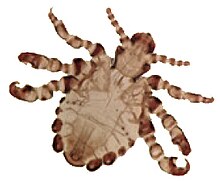Pthirus gorillae
| Pthirus gorillae | |
|---|---|

| |
| A magnified image of Pthirus gorillae | |
| Scientific classification | |
| Domain: | Eukaryota |
| Kingdom: | Animalia |
| Phylum: | Arthropoda |
| Class: | Insecta |
| Order: | Psocodea |
| Family: | Pthiridae |
| Genus: | Pthirus |
| Species: | P. gorillae
|
| Binomial name | |
| Pthirus gorillae Ewing, 1927
| |
Pthirus gorillae or gorilla louse is a species of parasitic sucking louse that afflicts gorillas.[1] It is found in the African continent, specifically in Rwanda and Democratic Republic of the Congo.[2] P. gorillae and P. pubis (the crab louse) are the only known species that belong to the genus Pthirus, often incorrectly spelled as Phthirus (the Greek word for louse is phthir).[3] It is suggested that it is transmitted among its hosts by social grooming, shared bedding and sexual contact.[4]
All species of sucking lice feed on blood.[5] They live in close association with their hosts and complete their entire life cycle on the host.[1] Pthirus gorillae infests the same parts of the bodies of gorillas as Pthirus pubis does in humans,[6] but since the gorilla is hairier, the lice tend to range over the whole body.[7] The two also resemble each other with the exception that Pthirus gorillae has large eyes that are placed on large lateral protuberances. A short and broad sucking louse, it is about 2.20 mm long with sprawling legs and not more than 20 small abdominal setae.[4]
It was first identified from specimens of mountain gorillas in 1927 by Henry Ellsworth Ewing during a game-hunting trip in what is now the Democratic Republic of the Congo.[4] Molecular phylogenetics suggest that P. gorillae jumped from gorillas to early humans 3.3 million years ago and diverged into the present-day pubic louse.[1][8] Researchers theorize that humans acquired the parasite while butchering or scavenging on gorilla carcasses, or sleeping in the abandoned sleeping nests of gorillas.[9][10]
Several lice of the species were found during a necropsy in the stomach of a female gorilla from Bwindi Impenetrable National Park; she had presumably been grooming before she died.[4]
The conservation status of this species is unknown. Since its host species is critically endangered, it is likely that this species is endangered too.
References[edit]
- ^ a b c David L. Reed; Jessica E. Light; Julie M. Allen; Jeremy J. Kirchman (2007). "Pair of lice lost or parasites regained: the evolutionary history of anthropoid primate lice". BMC Biology. 5: 7. doi:10.1186/1741-7007-5-7. PMC 1828715. PMID 17343749.
- ^ "Pthirus gorillae Ewing, 1927". Integrated Taxonomic Information System. Retrieved 30 September 2010.
- ^ Robert Frederick Harwood; Maurice Theodore James (1979). Entomology in human and animal health. Macmillan. p. 130. ISBN 978-0-02-351600-9.
- ^ a b c d Jessica M. Rothman; Dwight D. Bowman; Gladys Kalema-Zikusoka; John Bosco Nkurunungi (2006). "The Parasites of the Gorillas in Bwindi Impenetrable National Park Uganda". In Nicholas E. Newton-Fisher; Hugh Notman; James Durward Paterson (eds.). Primates of Uganda. Springer Science+Business Media. pp. 171–192. ISBN 978-0-387-32342-8.
- ^ Jonathan F. Day; John D. Edman; Sidney E. Kunz; Stephen K. Wikel (2004). "Direct Injury: Phobias, Psychoses, Annoyance, Allergies, Toxins, Venoms and Myiasis". In Bruce F. Eldridge; John D. Edman (eds.). Medical Entomology: A Textbook on Public Health and Veterinary Problems. Kluwer Academic Publishers. pp. 99–149. ISBN 978-1-4020-1794-0.
- ^ Robert S. Anderson; Richard Beatty; Stuart Church (2003). "Sucking louse". Volume 5. Harvester ant–Leaf-cutting ant. Insects and Spiders of the World. Marshall Cavendish. pp. 520–523. ISBN 978-0-7614-7339-8.
- ^ Sydney Harold Skaife; Anthony Bannister (1979). African Insect Life. C. Struik. p. 83. ISBN 978-0-86977-087-0.
- ^ May R. Berenbaum (2009). "The Domesticated Crab Louse". The Earwig's Tail: A Modern Bestiary of Multi-legged Legends. Harvard University Press. pp. 24–28. ISBN 978-0-674-03540-9.
- ^ Roxanne Khamsi (7 March 2007). "Pubic lice leapt from gorillas to early humans". New Scientist.
- ^ Jesse Bering (1 March 2010). "A bushel of facts about the uniqueness of human pubic hair". Bering in Mind. Scientific American. Retrieved 30 September 2010.
External links[edit]
- Apes, lice and prehistory by Robin A Weiss
- Genetic Analysis of Lice Supports Direct Contact between Modern and Archaic Humans by David L. Reed et al.
